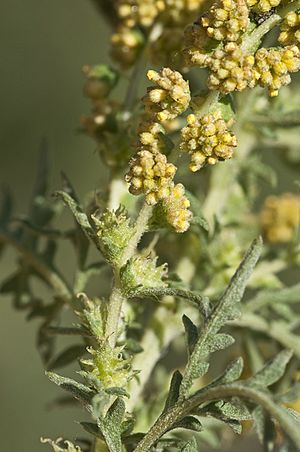Weakleaf bur ragweed facts for kids
Quick facts for kids Weakleaf bur ragweed |
|
|---|---|
 |
|
| Scientific classification | |
| Genus: |
Ambrosia
|
| Species: |
confertiflora
|
Weakleaf bur ragweed (scientific name: Ambrosia confertiflora) is a type of ragweed plant found in North America. It's known for its small, spiny fruits that can stick to things, like burrs!
Where Does It Grow?
This plant is originally from many parts of northern Mexico, from a state called Sonora all the way to Tamaulipas. It also grows naturally in the southwestern United States. You can find it from California in the west, stretching east to states like Kansas, Oklahoma, and central Texas.
Sometimes, plants spread to new places where they didn't grow before. When this happens, we say they are naturalized. Weakleaf bur ragweed has become naturalized in other areas around the world. In places like Australia and Israel, it's even considered a noxious weed. This means it's a plant that can cause problems, like harming crops or other native plants.
What Does It Look Like?
Weakleaf bur ragweed is a plant that grows back year after year, which means it's a perennial herb. It can grow quite tall, from about 30 centimeters (that's like a big ruler) to almost two meters (taller than most people!). Its stems stand straight up and can be bristly or fuzzy, with colors from green to brown.
The leaves are also fuzzy and have many lobes, meaning they are deeply divided into several parts. These leaves can be almost 16 centimeters long. They grow on stalks called petioles, which have small, wing-like parts.
Like other ragweeds, this plant has special flower parts. It has separate male and female flower clusters. The male flowers produce pollen, and the female flowers produce seeds. After the female flowers are pollinated, they create one or two fruits. These fruits are like small, spiny balls, called burrs, and can be up to half a centimeter long. They are covered in short spines, which help them stick to animals or clothes, spreading their seeds around!

